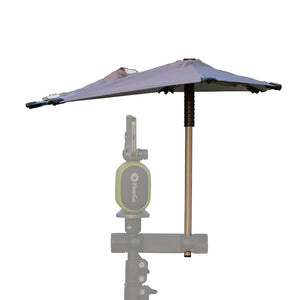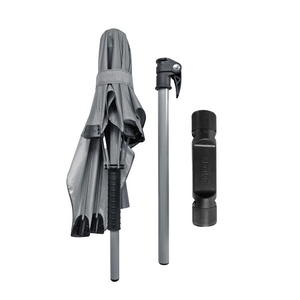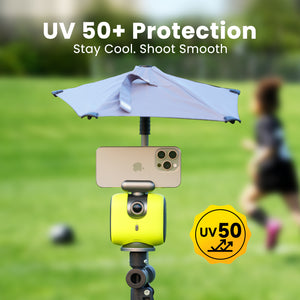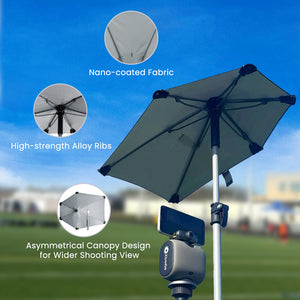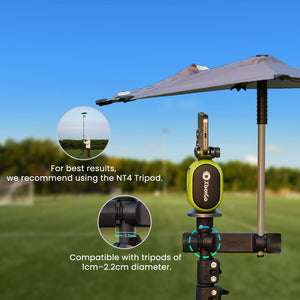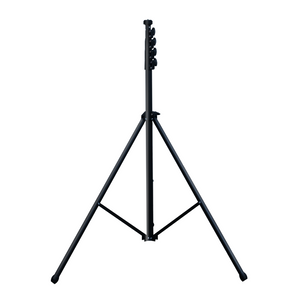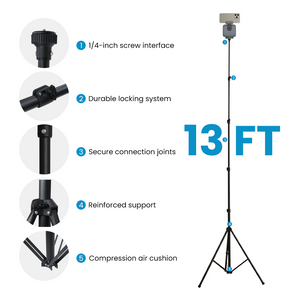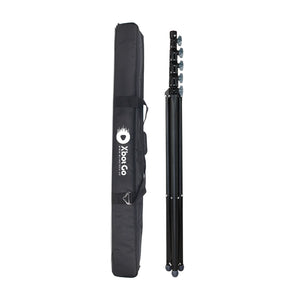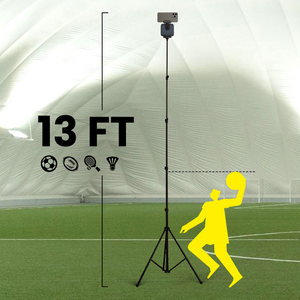XbotGo Chameleon AI Sports Camera
Why Do Hockey Players Use Smelling Salts?
Watch any NHL game closely, and you'll spot it—players on the bench dramatically recoiling after sniffing mysterious packets, their faces contorting like they've just bitten into the world's sourest lemon.
This peculiar pre-game and mid-game ritual has fascinated fans and confused newcomers for decades. So why exactly do hockey's toughest athletes voluntarily assault their own nostrils with these pungent packets?
The Science Behind the Shock
Let's start with what these little white packets actually contain. Smelling salts are capsules filled with ammonium carbonate or ammonium bicarbonate compounds. When you crack them open, they release ammonia gas—and that's where the magic (or madness) happens.
The ammonia doesn't just smell bad. It literally attacks your nasal passages by:
- Irritating pain receptors called nociceptors
- Stimulating trigeminal nerve endings in your nose
- Forcing an involuntary inhalation reflex
- Activating your sympathetic nervous system
Think of it as a chemical slap to your respiratory system. Your body responds by increasing heart rate, dilating pupils, and forcing deeper breaths—all within seconds of exposure. As one player cleverly explained, "It's like getting a singular toad boost thing in Mario Kart, it'll give you a boost, but only for like half a shift."
When Hockey Players Actually Reach for the Salts
Through extensive research and player testimonials, clear patterns emerge about when and why players use smelling salts. The reality might surprise you.
Late Night Wake-Up Calls
The most common use? Combating the mental fog of late-night games. One beer league player shared: "Our games are at 10:40 at night so at that point I'm almost asleep mentally. Helped a little to shake off the sleepiness, but not much more than that."
For recreational players juggling work, family, and hockey, those 10 PM puck drops hit different. Smelling salts become a last-resort tool when coffee isn't practical and you need to snap into game mode fast.
Third Period Energy Crisis
Players consistently report using smelling salts during energy lows, particularly in the third period. As one player revealed: "My personal routine was using them when I was losing my energy the most—in the middle minutes in the third."
The strategic timing matters. Rather than using them constantly, experienced players deploy smelling salts like emergency reserves—saving them for when natural adrenaline dips and fatigue threatens performance.
Post-Hit Fog Clearing
Here's where things get controversial. Historically, smelling salts helped revive unconscious people. In hockey, some players use them after hard hits to "clear their head." But medical professionals warn this practice can be dangerous, potentially masking concussion symptoms that require proper evaluation.
The responsible approach? Save the salts for simple fatigue, not potential head injuries.
The Unexpected Medical Benefits
Some players discovered legitimate medical applications. One player with a broken nose explained: "I use them because I have a broken nose that blocks the airway on my left side most times, it really helps me clear my nose and let me breathe."
Others report the eye-watering effect helps refresh dry contact lenses during long games—an unexpected but welcome side benefit.
The Performance Enhancement Myth
Here's what might disappoint the believers: scientific evidence shows smelling salts don't actually improve athletic performance. The effects are purely temporary arousal of the nervous system, lasting seconds to maybe a minute.
Experienced players are refreshingly honest about this reality. As one put it: "Wakes you up, that's for sure! Improved performance, eh. I don't think it improves your reflexes."
Another player with a scientific background added: "It activates the sympathetic nervous system... The effects aren't too long lasting and I highly doubt it makes anyone a better hockey player. Gimmick in my view."
So if they don't enhance performance, why the continued popularity?
The Psychology and Ritual Factor
The real power of smelling salts might be mental rather than physical. Hockey players are notoriously superstitious, and smelling salts have become deeply embedded in the sport's culture.
Consider these psychological factors:
- Pre-game rituals create mental readiness
- Team bonding through shared experiences
- Placebo effect from believing in the boost
- Professional mimicry as amateurs copy NHL players
One player noted: "They are good for having fun in the locker room before the game. Good for a laugh watching teammates try a sniff."
The ritual itself—the preparation, the anticipation, the dramatic reaction—might provide more benefit than the actual chemical response. It's hockey's version of a war cry, a shared experience that bonds teams and prepares minds for battle.
Real Risks You Need to Know
Before you rush to Amazon for your own supply, understand the legitimate health concerns:
The Concussion Masking Danger
The most serious risk involves head injuries. Smelling salts can temporarily make a concussed player appear alert, masking symptoms that require medical attention. This false alertness could lead to catastrophic decisions about returning to play.
Chemical Burns and Respiratory Issues
Hold those salts too close or use them too frequently, and you risk:
- Chemical burns to nasal passages
- Respiratory irritation or bronchospasm
- Lingering smell affecting taste for up to 24 hours
One player warned: "For me the annoying part was that for the next 24 hours any time I would breathe through my nose it felt like I was getting another whiff of that awful smell."
Individual Variations Matter
Not everyone responds the same way. One player discovered through genetic testing that they couldn't properly metabolize stimulants, making smelling salts potentially dangerous for them. Your body chemistry matters.
Smart Strategies from Seasoned Players
If you're still considering smelling salts, learn from those who've mastered their use:
Timing Is Everything
- Use during specific energy lows, not constantly
- Deploy between periods rather than before games
- Save for crucial moments, not routine shifts
Product Selection Matters
Players recommend:
- Reusable bottles over single-use capsules
- Pre-mixed solutions for consistency
- Brands specifically made for sports use
Combine with Other Strategies
Smart players use smelling salts as part of a broader approach:
- Pre-workout supplements before games
- Strategic caffeine timing
- Proper hydration throughout
Healthier Alternatives That Actually Work
Many players have discovered effective alternatives without the chemical assault:
Environmental Solutions
"A brisk walk outside the rink when it was minus 15 outside" worked better than salts for one player. Cold air naturally increases alertness without risks.
Natural Energy Management
- Strategic napping before late games
- Proper warm-up routines for natural energy
- Breathing exercises for mental clarity
- Music and visualization for psychological preparation
Nutritional Timing
- Appropriate pre-game meals
- Strategic caffeine use
- Consistent hydration
- Avoiding energy-crashing foods
The Future of Hockey's Controversial Custom
The tide might be turning against smelling salts. Consider these developments:
- Hockey Quebec banned their use in organized activities
- The NFL restricted team-provided smelling salts
- Boxing prohibited them in most competitions
- Medical professionals increasingly warn about masking injuries
Youth hockey faces particular scrutiny, with medical experts strongly discouraging use among younger players who might not understand the risks or have the judgment to use them safely.
The Bottom Line: Should You Use Them?
For adult recreational players, the decision comes down to personal choice and league rules. If you're considering smelling salts:
Maybe consider them if:
- You play very late games and struggle with alertness
- You have no respiratory conditions
- You understand they won't improve your actual performance
- You're seeking a psychological boost, not physical enhancement
Definitely avoid them if:
- You have any history of head injuries
- You have asthma or breathing issues
- You prefer natural energy solutions
- Your league discourages their use
The Final Wake-Up Call
Smelling salts in hockey represent a fascinating blend of science, psychology, and tradition. While they do provide a real but brief jolt of alertness through ammonia irritation, their main value lies in psychological ritual rather than actual performance enhancement.
The honest truth from experienced players? They might wake you up for seconds, but they won't make you a better hockey player. Their popularity reflects hockey's superstitious culture and the power of pre-game rituals.
Whether you see them as harmless tradition or unnecessary risk, smelling salts remain one of hockey's most distinctive practices—reminding us that the most interesting aspects of sports often have nothing to do with the final score, but everything to do with the human stories that define the game.
Just remember: if you try them, that smell might stick around longer than you'd like. Some experiences can't be unsmelled.
XbotGo Chameleon AI Sports Camera
Capture every moment with AI-powered tracking. Perfect for coaches, parents, and athletes who want seamless footage without manual filming.







 Soccer
Soccer Basketball
Basketball Ice Hockey
Ice Hockey Rugby
Rugby










